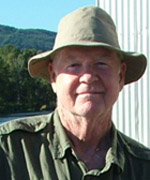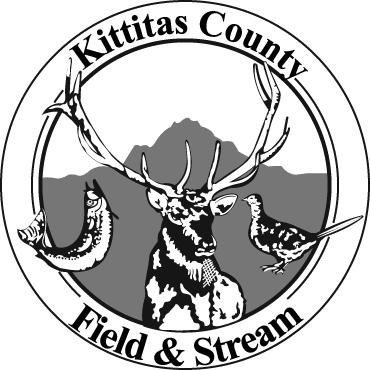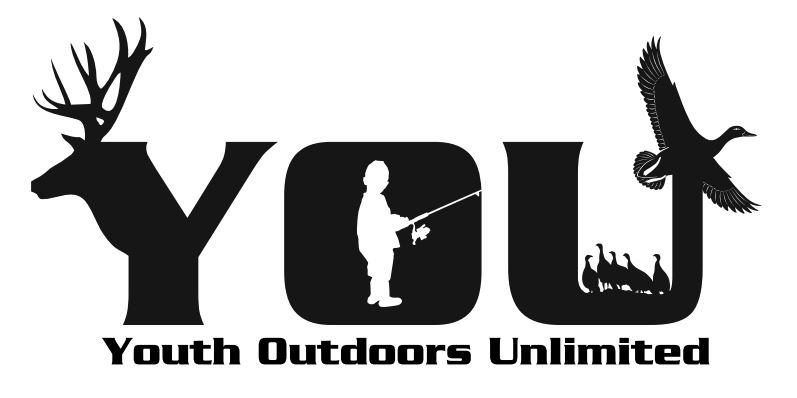Archive for August, 2017
Thoughts about Good Shooting and Fall Prep
It is that time. To be ready for upcoming fall hunting seasons, we now get serious about checking ammo supplies, status of reloading gear, condition of firearms and availability of time and location of places to sight-in our hunting firearms – or to just go squeeze off a few rounds. (Some of us get really serious about squeezing off “a few rounds” – more on that, later.)
We spend a lot of time practicing with our firearms and ammo (as do our bowhunting buddies with their bows and various arrows and broadheads). We do this to ensure that, when we are given an opportunity to make meat, we are able to do so quickly and humanely.
At the range – when we are testing those combinations of bullets and powder – we may debate such things as the best way to ensure accuracy at various ranges. I will hear about rangefinders and modern rifle scopes which will take the guess work out of any shot at any range under any condition. And I will simply follow the guidance and wisdom of the late Jack O’Connor. He assured me that the rifles and ammo I shoot ought to be sighted in to hit three inches above dead center at 100 yards, so that the bullet will strike within three inches above or below the point of aim anywhere out to 300 yards. No doubt, this will be cussed and discussed, but it has not failed me for 65 years, so… Ultimately, each of us wants to know that the tools we use afield will perform exactly as we expect them to perform. Thus, we practice, and practice.
The “where’ of our practice can be challenging at times. The Cascade Field and Stream Club range on Hayward Hill is a fine range for club members (and most anyone may join, of course). A good many of us will go out onto Durr Road, in the Washington State Wenas Wildlife Area and shoot during the sunrise to 10 a.m. time now allowed. Others may have other safe places to shoot. Outdoor range options for us all will likely expand once the Wenas Shooting Advisory Group completes its recommendations to DFW.
A good many of us developed our shooting interest and skills at indoor ranges as youngsters. You are aware of the Kittitas Valley Rifle and Pistol Club (KVRPC) and its annual indoor Light Rifle Class League here in Paradise. This 16-week winter league gives families an opportunity to bring their favorite .22 caliber rimfire rifle (or .17 or larger serious air rifle), and ammo, and have an evening of safe fun putting little holes in paper. The club provides regulation 10-bull NRA targets, a modern heated range facility, the direction of a qualified range master and coaching as needed/desired. Friends speak of the league as a terrific chance to discover (and rediscover) the joy of safe recreational shooting and of watching a kid or grandkid develop skill and confidence. Those lifelong skills, honed at a local range, can take people places.
Meet Erich Mietenkorte, local shooter and Vice President of the KVRPC. Erich recently returned from a trip to Fort Steele, British Columbia. What took him to Canada was the 2017 Canadian National Rifle Silhouette Championships, hosted by the Bull River Shooters Association, between July 30 and August 5. The headline on the story forwarded to me by Hal Mason (another stalwart of the KVRPC) read, “Talented Yank Shines at Canadian Silhouette Championship.”
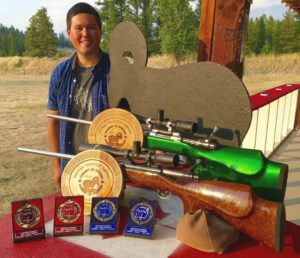 Erich has been active in silhouette competitions around the West for several years. He has some skills: at that Canadian Championship shoot, he took First Place in Master Standard Rifle, Second Place in Master Hunter Rifle, and Third Place in Master Smallbore Hunter. The first two events were shot at longer range with his .260 Bobcat (a 6.5×250 wildcat), and the third set of silhouettes was handled with his .22 rimfire rifle (known for its “wicked cool paint job and fighter plane graphics”).
Erich has been active in silhouette competitions around the West for several years. He has some skills: at that Canadian Championship shoot, he took First Place in Master Standard Rifle, Second Place in Master Hunter Rifle, and Third Place in Master Smallbore Hunter. The first two events were shot at longer range with his .260 Bobcat (a 6.5×250 wildcat), and the third set of silhouettes was handled with his .22 rimfire rifle (known for its “wicked cool paint job and fighter plane graphics”).
(Find a variety of Erich’s photos and an interesting write-up at, bulletin.accurateshooter.com/2017/08/talented-yank-shines-at-canadian-silhouette-championship/comment-page-1/#comment-53247.)
So, Erich is one of those guys who get really serious about sending a few rounds down range. He annually puts between 5,000 and 7,000 rounds through his competition .22 rifle, and some 1,500 through his high power 6.5mm centerfire. Add in the other shooting he does, and he figures he squeezes off 15,000 to 20,000 rounds a year. That is serious shooting. It obviously pays off; last weekend, Erich won the Washington State High Power Championship over in Pe Ell.
You will have to excuse me, now. I have some preparations to wrap up, and some reloading to complete. Then, I think I will go find a safe place to squeeze off a few rounds.
(Personal photo, on Erich Mietenkorte’s cell phone…)
Comments Off on Thoughts about Good Shooting and Fall Prep
A Wedding and “Wild” Blackberries
We spent the weekend at Anderson’s Bambooland, just east of Monroe, Washington, nestled between U.S. Highway 2 and the Skykomish River. The wedding was perfect, thank you. Thus, as of last Saturday, my young ever-eager fishing partner – formerly known as Boyfriend-in-Law Brian – graduated to Son-in-Law Brian.
Upon completion of the ceremony and all necessary pronouncements, the wedding guests and party surrounded the now-all-in couple. As Katie and Brian mingled, glowed, laughed and caught their collective breath, more and more of their fans drifted toward the perfectly-chilled malt beverage tap and growing piles of the amazing food one finds at these celebrations.
Bambooland is known for its acres of fine flower beds, orchard, and bamboo plants. And, virtually everything on the property is surrounded by blackberry brambles – those ubiquitous, unstoppable, Himalayan blackberries. At some point in the post-ceremony festivities, Cousins David and Debby Yount asked when we would pick blackberries. After all, they surmised, Diane and I would have to pick berries for Daughter Tena in Denver anyhow, so why not make a party of it on Sunday morning? Done.
As they turned back to more pressing matters, one of the other guests asked, “So what about all these berry tangles? I hear these are native to the West Coast… and not. They’re everywhere. What’s the story? How did they get everywhere?” Thus, another gauntlet dropped and I was duty-bound to pick it up.
We have three “growing wild” blackberries in the state.
Our only native blackberry is Rubus ursinus, commonly known as the wild mountain blackberry or the trailing blackberry, with some calling it a Northwest dewberry or Pacific blackberry. Some maintain that the “ursinus’ part of the name comes from the fall bears fattening on them. This is not a sprawling tangle, it trails across the ground. Its berries are smaller and sweeter – more delicate – and not that shiny black. Mountain blackberry’s juice runs a bright red and its seeds are tiny. They seem to be most commonly found on burned- or logged-over slopes of our east Cascades and on islands along the west coast.
Our two non-native blackberries produce large, seedy, and delicious berries. Both were introduced as food plants and both are now considered invasive Class C noxious weeds. The lesser known plant is Rubus laciniatus, the cut-leaf blackberry or evergreen blackberry – native to northern and central Europe. It has deeply incised leaflets in groups of three along its long thick trailing stems. Our more common blackberry is Rubus armeniacus, the Himalayan blackberry or Armenian blackberry its rounded, fine-toothed leaflets are in groups of five.
Both plants are highly invasive and almost impossible to control. You can’t miss them: they form large, extremely vigorous thickets of long tangled, dense canes covered with long (very sharp and backward-angled) thorns. (Blackberries are in the rose family, after all.) Plants joyfully reproduce with new canes forming almost wherever an older cane touches the ground, and the roots almost constantly send out new suckers. In King county, both species are on the non-regulated noxious weed list. Control of them is not required because they are so widespread throughout the county and the rest of Western Washington. (Control is recommended in protected wilderness areas and in natural lands that are being restored to native vegetation.)
The backstory of these berries is as tangled as the thickets themselves. Ann Dornfeld told the tale on Seattle’s NPR station, KUOW, in August, 2016. At the end of the 19th century, Luther Burbank, a contemporary and friend of Thomas Edison and Henry Ford, was determined to help folks moving west to easily grow local fruits and vegetables. Looking for seeds and plants which could take the rigors of rail and sea travel, he traded seeds with European colleagues and crossbred plants to produce those he considered to be best for certain areas – like the Pacific Northwest. His work in Santa Rosa, CA, produced plants like the Shasta daisy, freestone peaches and plums, elephant garlic and the potatoes most used today for fast food French fries.
Burbank worked to develop a thornless blackberry, but in a package he’d ordered from India was a huge, great-tasting blackberry. He called it the Himalaya Giant (now believed to have originated in Armenia). The blackberry grew like wildfire in temperate areas (that’s us). A mere decade after its 1894, introduction Burbank’s berry was moving across the Puget Sound region. It was soon known simply as “the Himalayan blackberry.”
Our Sunday picking? Well, true to form, we paid blood and skin for our many gallons of black beauties. (Best man Ed might have called it, “The cost of doing business in brambles…”) As the four of us worked our way down a long wall of thorny, fruit-laden Himalayan blackberry canes, various exclamations drifted by. I kept hearing “Wow, look at the size of these – Ouch!! Oh da#$@! – berries.” And “These are so – Ouch!! Ouch! – sweet and abundant! Ouch! Ach!”
Thank you, Luther Burbank. RIP…
Comments Off on A Wedding and “Wild” Blackberries
Backyard Mountain Lions
You have, no doubt, heard that Brian Kertson, DFW’s carnivore research scientist, will be at Ellensburg’s Hal Holmes Center Monday evening. At 7 p.m. he will be talking about backyard cougars. This is fascinating stuff. You are invited.
You may recall Project CAT (Cougars and Teaching) – the early-21st-century alliance of Cle Elum/Roslyn Schools, Washington Department of Fish and Wildlife, Pacific NW Center for Spatial Information and a handful of other high-profile partners. Evelyn Nelson, Super of the school district at that time, grew up in a hunting and outdoor-oriented family in Carson, down along the Columbia. With a long-burning desire to get kids hooked on the outdoors, she grabbed the chance to partner with Fish and Wildlife biologist Gary Koehler to start Project Cat and immerse her students in science and nature.
Over several years, Project CAT put Upper County K-12 kids at the front of research into the relationships between people and cougars. Brian was one of the grad student researcher involved with Gary Kohler and other biologists. A great deal of the CAT research involved remotely tracking and mapping cat movements. There was (and still is, really) no shortage of cats in the Upper County.
As it all came together, Gary or students would find a track and the Montana “cat tracker” contractor’s dogs would find the cougar, which ended up wearing a rather sophisticated geographic positioning system (GPS) collar. That collar stored the cat’s location as it went about its life. Periodically, the data in the collar was downloaded to a computer, and students would map a particular cat’s schedule and locations, plotting its range and paths.
Other groups of students worked on most everything from track or prey identification to necropsies. (One seventh grade class cleaned and reassembled the complete skeleton of a collared young male which apparently died from injuries inflicted by an elk or two.)
From several handfuls of collared cats, as hoped by Superintendent Nelson, those Upper County kids learned some things.
A typical male cougar’s summer territory covered 136 square miles, with three females occupying 50-60 square mile ranges generally within his. On average, there was one dominant animal per 46 square miles. With near-constant dispersal of young adults, one or more transient cats were regularly moving through the Upper County. (Two young cats actually traveled south to the Columbia River Gorge and back – several hundred miles.)
Using that GPS data, the kids plotted lion kills, identified prey species and age, and knew how much time the cat spent feeding; 60% of prey animals were deer and 40% were elk.
It turned out that cougars DID take deer and elk in people’s backyards, but they didn’t hang around, sitting and waiting; they were always moving through their home ranges. Interestingly – and no surprise – it was obvious that, if people FED elk and deer, or created a sanctuary, they greatly increased the odds of having cats in their backyards and neighborhoods.
The kids’ GPS data showed lions all around us – in the hills and in our backyards. In fact, if you’ve been hiking in the hills or woods, you likely have been seen or watched by a cougar.
Cats are several million years old, and in the last 200,000 years cougars have become highly evolved predators. Pound for pound, they kill bigger prey than any other predators (a 100 pound female lion will take down a 500 pound elk). By the way, cougars don’t chew; their carnassial (adapted for shearing) teeth bite off chunks of flesh for swallowing.
Although the odds of a run-in are very small, most problem cats will be young vagrants looking for territories. Rules of engagement are simple: stop, stand tall and don’t run; pick up small kids; don’t break eye contact; be as large as possible (wave arms, hold up branches or coats); back away; pick up sticks and stones and fight back if attacked. Carry pepper spray. (Remember, Teddy Roosevelt called the cougar the greatest coward among the predators of North America.)
Funny thing about lions and people. Colorado wildlife buddy Bob Hernbrode often spoke of people and bears. Hear his words with [lion] replacing “bear.” “People who live in [lion] country will almost always tell you so. While it is sometimes presented as a warning, it is in reality an effort to describe some ephemeral value of the land. Most people will never see a [lion] in their mountains, yet the mere possibility of doing so imparts some vital uncertainty, mystery, danger, a need for respect, and greater depth to the landscape. We need [lions] in our mountains.”
We know a great deal about the backyard cats of Paradise. Brian Kertson has carried his work and research into the heavily-populated west side of our state. Thus, Monday night’s talk.
See you Monday evening at the Hal Holmes Center.
Comments Off on Backyard Mountain Lions
Another Kenai River Adventure
I was explaining to Homey that, while the Upper County fishing hike would be one I have wanted to take for some time, I could not join him. I had to be in Alaska during that time.
“What’s this HAVE to be in Alaska business?” “Well, I have to go to the Kenai for sockeye salmon,” I explained. “There are a couple good reasons. First, if I do not get my new nine-weight rig onto the Kenai River, it may never behave properly when I take it elsewhere. Secondly, I go with Homey Bill Boyum and his son, Honorary Homey Jon, the thoracic surgeon. They depend on me for comic relief. I have to go fish in Alaska with them.”
I’m not sure he bought the story, but he did finally acquiesce. Maybe he understood the importance of honoring the tools of our outdoor pursuits. And perhaps the value of tradition and deep friendships. Be that as it may, Alaska called.
We convened a bit over a week ago, on a late Monday night, at Anchorage International Airport. We piled into a simple and significantly overpriced rental car and found our way to a night’s lodging. Early the next morning, we pointed the vehicle more-or-less south, skirting Cook Inlet and moving through forests and mountains toward the town of Soldotna on the Kenai Peninsula.
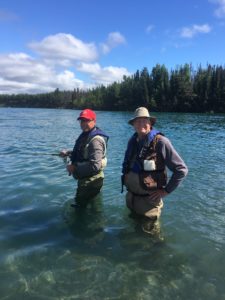 The two and a half hour drive took us to our cozy cabin – home for the few days – at Steve and Lea Stuber’s Red Fish Lodge on the Kenai. Since it was too early to check in, we piled our luggage on the office deck, grabbed our gear and headed to a salmon-likely reach of the river.
The two and a half hour drive took us to our cozy cabin – home for the few days – at Steve and Lea Stuber’s Red Fish Lodge on the Kenai. Since it was too early to check in, we piled our luggage on the office deck, grabbed our gear and headed to a salmon-likely reach of the river.
Somewhere in there, Bill reached out to John Wensley, a friend from his early DNR days, now retired from teaching and living over in the town of Kenai. John had a couple suggestions for less crowded fishing.
As you may know, these sockeye do not hit a lure in the traditional sense. It seems a mystery, but somehow a hook with a bit of brightly colored floss bounced along the bottom gets us fish. The sockeye move up the river in relatively shallow channels rarely more than 10 or 12 feet from the gravel bars or shorelines along which we stand. One casts 15 or so feet out, and swings the flossed hook in an arc across the channel. If you hit a snag, but it moves, you attempt to set the hook. Any fish hooked outside the jaw, or behind the gills, is foul-hooked and released. My vision of all this is that the fish snap at our floss as it tickles their noses or jaws and as they “breathe,” moving water over their gills. These are beautiful, shiny, and delicious six to 15-pound red salmon. Once you find the groove, and present your hook successfully, the whole experience is seductive and habit-forming.
We added some new experiences this year. For starters, Dad Bill caught his limit of three salmon before Son Dr. Jon Thinks-Like-A-Salmon for two days in a row – some sort of new record.
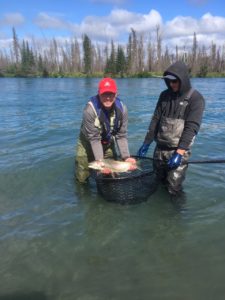 We hired a fishing guide (Alex of Chasing Tales) for a day: partly so we could get to new places and learn new techniques; partly for some trout fishing; and partly to see more of the river. The day yielded limits of salmon and some very enjoyable catch and release trout fishing for Dolly Varden (a char, really) and rainbows up to 16 inches. Somewhere in there, however, Dr. Jon caught a stunning 25-inch, five-pound-plus rainbow. And we all upped our skill levels.
We hired a fishing guide (Alex of Chasing Tales) for a day: partly so we could get to new places and learn new techniques; partly for some trout fishing; and partly to see more of the river. The day yielded limits of salmon and some very enjoyable catch and release trout fishing for Dolly Varden (a char, really) and rainbows up to 16 inches. Somewhere in there, however, Dr. Jon caught a stunning 25-inch, five-pound-plus rainbow. And we all upped our skill levels.
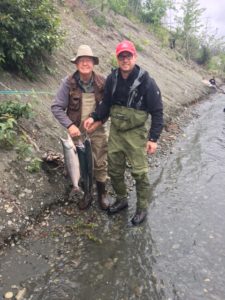 We hiked in to several new reaches of the river. We never found the crowds (walking by 70 to 80 fishers to find a spot, for example) of past years, but there were still fishers everywhere – easily 1,200 to 1,500 along the Kenai’s banks and islands on any given day.
We hiked in to several new reaches of the river. We never found the crowds (walking by 70 to 80 fishers to find a spot, for example) of past years, but there were still fishers everywhere – easily 1,200 to 1,500 along the Kenai’s banks and islands on any given day.
At one point, Bill and I were working a very productive channel. In walked a young fellow with his apparent squeeze, and as he explained his expertise to her, he walked directly into the channel, and the sockeye moving upstream. I bit my tongue for a short time, but when he moved directly in front of me, within my cast distance, I explained in a quiet, but clear, way that I would not do that to him and he shouldn’t be standing in the fish’s channel, and maybe a couple other things. Bill, fishing on the downstream side of them, was chuckling and tempted to tell them that I was just a cranky old #@$& and he would take me home. As we wrapped up and worked our way to dry ground, I stumbled over a slippery rock and took a wader-filling header – just as we had been noting that none of us fell in this year. Some sort of karmic moment, I suppose.
On our last day, we hiked in to one of our favorite spots with Bill’s old friend John and a fellow teacher, Jeremy. Not wanting to hike our nine salmon back through the woods, Jeremy opted to filet them at the river. He laid the stringer of fish up on the gravel. As he worked on the first two, a speeding boat pushed a big wake up onto the gravel shore, and the seven remaining fish, with stringer, headed down the river – sort of a once-in-a-lifetime experience. During our hike out with our now two fish, we noted that no one got hurt, no one died, and the bears would likely find the fish. Bill mourned the loss of his all-time favorite 69 cent stringer.
Even with that loss, we brought back more than 100 pounds of filets, plans for next year, new friendships, warm memories, and plenty of laughter.
I think that’s why we went.
[Photos of Jon and Jim, and Jon and Alex, by Bill Boyum.]

